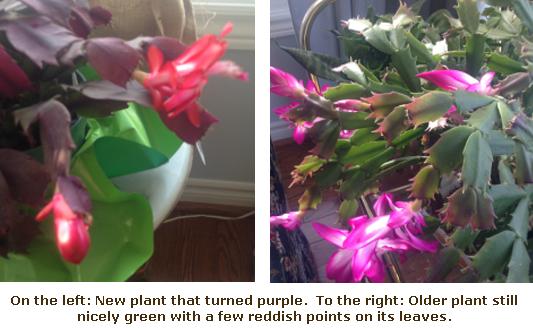My newer Christmas Cactus has purple leaves! They’ve turned from a green to a purplish red. Weird but attractive. I wondered why as overwatering didn’t seem to be an issue. But I also wondered if they could ever turn green again! If yours are turning purple – even a bit – consider that they just finished blooming for Christmas and most will bloom again for Easter. So now is the time to fix the issue.
Why do they turn purple? I started looking for advice and as many of you might do as well, I asked Mr. Google. Oftentimes, a purplish tint to your Christmas cactus leaves is normal. That said, if it’s noticeable throughout the leaves, it may signal an issue with your plant. Seems there are 4 main reasons why Christmas Cactus turn purple. Who would have guessed? They are stress, nutritional issues, crowded roots, and temperature issues.

Stress – Just like us, Christmas Cactus can get very stressed out! Turning purple is the plant's way of responding to environmental stress. Succulents, agave, and aloe varieties also turn reddish, burgundy, or purple when exposed to stress. And if you catch this early, you can likely stop further colouring. What causes these plants to be stressed? Several things –
Nutritional issues – If you don’t fertilize your Christmas cactus regularly, the plant may be lacking the necessary nutrients. Feed the plant monthly from spring until mid-autumn with a general-purpose fertilizer for indoor plants. Additionally, because Christmas cacti require more magnesium than most plants, it normally helps to provide a supplemental feeding of 1 teaspoon (5 ml) of Epsom salts dissolved in one gallon of water. Apply the mixture once every month throughout spring and summer, but do NOT use the Epsom salt mixture the same week that you apply regular plant fertilizer.
Crowded roots – If your Christmas cactus is rootbound, it may not be absorbing nutrients effectively. But they do like crowded roots so don’t repot them unless it has been in that pot for at least 2 to 3 years. If it needs repotting, it is best to repot in the spring so your time to do this is coming!
Temperature Issues – They sometimes turn reddish-purple when their roots overheat or guess what? They also can turn red or purple when they get too cold! Move them to avoid placing your plant in extreme temperature conditions. So don’t put it near a fireplace, heater, fan, cooling or heating vent, nor a drafty window or a door that is frequently opened. And a good thought – don’t plant it in a black plastic planter which will overheat as it absorbs the sun’s rays in the summer. Perhaps try a light-coloured clay pot. My mom made special African violet clay pots - she did ceramics, and taught, pottery and ceramic classes. The pots are 2 pots really – one rounder one to hold the water and one like a deep pie dish with ruffled edges to hold the plant with its soil. You put water in the bottom one and then put the pie dish one back into the one with water. If you see one of these, do get it for your African violets. These plants do require bright light during fall and winter, but too much direct light during the summer months may also be the reason for Christmas cactus leaves turning purple on the edges.
Will they ever return to green leaves? This was my second question and I couldn’t find anyone who had a positive answer. If the leaves are just starting to turn purple, then it seems they could return themselves to normal green leaves by following the notes above. If they are more than a little purple, at least following the notes will stop further colouring. But if they are totally purple, no promises are made. Experts hold out a small glint of hope that the plants could at least improve in health and not die if you reduce their stress.
Bottom line. Purple Christmas Cactus are attractive and unique, and a healthy plant is better than no plant; so, I’ve started to repot and relocate my purple Christmas Cactus! It's now 3 years old!
Article and photos by Doreen Coyne, a member of the Richmond Hill Garden & Horticultural Society



